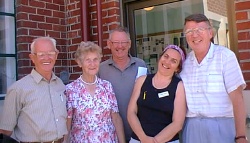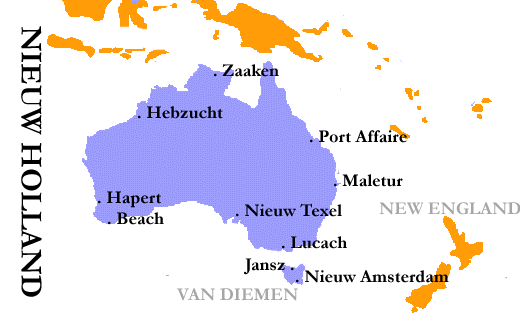 This story follows one of history’s unexplored paths. What if
Australia hadn’t been colonised by the English, but by those Europeans who had
preceded them, the Dutch? This path begins at a subtle historical juncture in the early
seventeenth century. Well before the English set their minds on colonising the antipodes,
the Dutch had begun harvesting the riches of the East Indies. Why, given the success of
this trading venture, didn’t the Dutch pursue the possibilities of the fabled
southern continent? For centuries, such a land was the stuff of dreams about mountains of
gold and precious jewels. Why was their contact with the continent so incidental? This story follows one of history’s unexplored paths. What if
Australia hadn’t been colonised by the English, but by those Europeans who had
preceded them, the Dutch? This path begins at a subtle historical juncture in the early
seventeenth century. Well before the English set their minds on colonising the antipodes,
the Dutch had begun harvesting the riches of the East Indies. Why, given the success of
this trading venture, didn’t the Dutch pursue the possibilities of the fabled
southern continent? For centuries, such a land was the stuff of dreams about mountains of
gold and precious jewels. Why was their contact with the continent so incidental?The first mistake occurs in 1605, when Captain Willem Jansz sailed the Dufken to explore territory south of New Guinea. An encounter with hostile natives decimated his crew and the ship was unable to explore any further the coast of northern Australia. What if Jansz had tread a little more carefully in this area, he may have returned with a fuller account of the southern continent? Early in the seventeenth century, the Dutchman Isaac Lemaire founded the Australia Company, with a mission to reap the wealth of this new continent and establish a venture to rival the Dutch East Indies Company. Unfortunately, this competitor scuttled his plans by commandeering his ship while it was docked in Batavia. What if Lemaire has chosen a friendlier port, and uncovered some of the richer lands of western Australia? Going off the beaten track… |
The prospectus for Lemaire’s Australia Company heralds
the untold wealth offered by the fabled Southern Continent. These promises attract much
investment, particularly from those traders who disapprove of the monopoly imposed by the
Dutch East Indies Company. With this money, Lemaire launches a fleet of ships to claim the
fertile fields of the continent’s southwest. The first settlement is blessed with rich farming land. The Dutch, however, are reluctant colonists. The thought of ending their days in a far-flung corner of the world had no romantic appeal. Lemaire returns to The Netherlands with the hope of inspiring more to join his ‘Nieuw Hollanders’. Fortunately, political circumstances are in his favour. In the Twelve Year Truce between successive wars with the Spanish, anti-Catholic feeling is high. The majority opinion favours suppression of all religions apart from the dominant Calvinist belief. There are many Protestants, however, who support religious toleration. Their leader, Oldenbarnevelt, had been charged with treason and is about to be hung. Fearing riots, the government had commuted his sentence to exile. Seizing the opportunity, Lemaire offers Oldenbarnevelt a promised land of religious toleration for him and his supporters. With little choice, Oldenbarnevelt agrees and leads a large contingent of settlers, including some Catholics, some moderate Protestants, but mostly Flemish who have fled north during the wars and fear the onset of more bloodshed. Oldenbarnevelt settles in a large river port on the west coast of Nieuw Holland. This village is called Harpert, after his old home town. Though suffering greatly from homesickness, the settlers embrace the challenge to establish a community of free thinking far from the troubles of Europe. The original inhabitants of this area, the Nunga people, do not accept these noble sentiments. Oldenbarnevelt attempts to negotiate a sale of land with the Aboriginal people, but this is fraught with misunderstandings. The settlers are horrified when they are forced to repel an attack with force, but find themselves with nowhere else to turn. The local tribes eventually move on to land of neighbouring tribes, and war breaks out between Aboriginal populations. |
| Harpert locates itself at the end of the trade winds that
sweep across the Indian Ocean, connecting the west coast of Nieuw Holland with the Cape of
Good Hope. This route soon extends to van Diemen’s land, a large island off the north
west of Nieuw Holland. This island develops a quite cosmopolitan culture, providing a
meeting point for Dutch, French, English and even Japanese cultures. The northern port of
Jansz is a haven for the finer arts. Rich sumptuous oil paintings of the island remarkable
landscape inspire a romantic turn in Dutch painting. Travellers from all corners of the
world are attracted by its exotic location at the end of the world, its
‘primitive’ peoples and strange fauna, including the fabled tiger. When the
Dutch lose New Amsterdam to the English, who rename it New York, this title is granted to
the young southern port of van Diemen’s land. Enterprising Dutch merchants and traders quickly locate the main sources of wealth in Nieuw Holland. Mines for gold and other minerals are established throughout the west, particularly the northwest. Unscrupulous merchants import slaves from southern Africa to supply the manpower needed to run these operations. For many years, these workers are explained away as a peculiar tribe of Aborigines. Yet with so much open land surrounding the mines, the operators have difficulty keeping their slaves. Many escaped slaves are harboured by Aboriginal communities displaced by European occupation. The Zulu tribesmen in particular teach indigenous Australians how to wage war on the settlers. This leads eventually to a bloody confrontation between black and white populations. Luckily, the presence of Tembu slaves provides the black peoples with a good stock of negotiators. The colonists eventually agree upon the establishment of several homelands for different Aboriginal groupings. This contract is called the ‘Balanda Treaty’ after the Aboriginal pronunciation of Hollander. While appeasing the majority of parties, there is nonetheless continuing conflict over its details. Occasionally a strict Calvinist sect arises to claim a homeland of its own. While the Australian Company concentrates on the broad sweep of the southern seaboard, the Dutch East India Company begins to establish an outpost on the north of Australia. The company also allows the establishment of a French penal colony on the northeast coast of the country. There is fierce resentment of this invasion, but little the Nieuw Hollanders could do to prevent it given the limited resources of their military and huge expanse of land to be protected. Instead, they concentrate on the technological challenges of a dry continent. A series of windmills along the central coast provides artesian water for agriculture. This eventually leads to the ‘greening’ of the dry centre. The foremost wonder of their nation is the Tasman Bridge that links the island of Tasmania to the mainland. Nieuw Holland becomes a republic after the First World War, when the new country is anxious to extricate itself fully from the horrors of European battles. Defence of the motherland was never a powerful motive in Balanda life. The country is divided into sixty nine separate provinces, each with their own level of government. Nieuw Hollanders take to self-government very seriously, with high participation in local councils at ground level, and intense interest in the parlement at a national level. Today, Nieuw Holland is famous for its technological advances and engineering feats. Their currency is the florin and their motto is fortiter in re, suaviter in modo. Despite their successes, the republic is fraught with many problems, including a thriving drug trade, a range of righteous interest groups and pockets of severe pollution. In an attempt to rise above these problems, Nieuw Holland is about to launch the world’s first virtual democracy, allowing for popular participation in government decision-making. |
|
| Local Dutch settlers Jo and Lisa Eshuys, Alex Fievez, Ded Heineman were joined by radio activist Loren Nania in constructing the fraught history of the Dutch colonisation of Australia. |  |
| Last edited 23 September 2004 | Please email your response to this story to the exhibition curator, Kevin Murray. |
